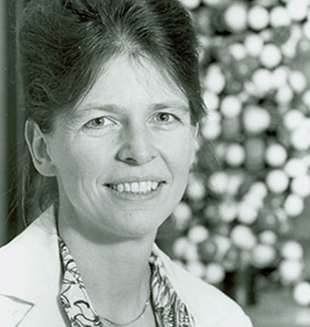

Joan A. Steitz (1941 )
“One of the greatest joys in science is realizing that you know something that nobody else knows.”
–Joan A. Steitz
National Medal of Science recipient in 1986 “for her major contributions to the basic molecular biology of bacterial and mammalian cells. Her discovery of at least six new components of the cellular machinery is an accomplishment of great distinction in both basic molecular biology and in the clinical treatment of autoimmune disease.”
Joan A. Steitz was born Joan Argetsinger in Minneapolis, Minn. Though she grew up with very few female role models in science, her parents, both teachers, urged her to pursue her interests. After earning her bachelor’s degree in chemistry from Antioch College, Steitz applied to Harvard University Medical School because she knew of female doctors but not female scientists.
The summer before she was to begin medical school, Steitz worked in the lab of Joe Gall at the University of Minnesota. With Gall’s encouragement, Steitz transferred to Harvard’s doctoral program in biochemistry and molecular biology. She was the only woman in her class of 10.
When Steitz arrived at Harvard, she approached a well-known faculty member and inquired about working in his lab. Steitz recalls that the professor looked at her and responded, “But you’re a woman. What will you do when you get married and have a family?”
Disheartened, but determined to find a lab, Steitz met with James Watson, whom she had gotten to know through her work with Joe Gall and her coursework at Harvard. Steitz became the first woman to be accepted in the Watson laboratory.

Joan A. Steitz receiving the National Medal of Science from President Ronald Reagan.
In 1966, Steitz married her Harvard classmate Thomas Steitz, and the two moved to Cambridge, England, for postdoctoral work. They returned to the United States in 1970 to accept positions at Yale University, where Steitz made a huge breakthrough working with antibodies from lupus patients. Her research on small nuclear ribonucleoproteins (snRNPs, pronounced “snurps”), may have a significant impact on the diagnosis and treatment of lupus.
Steitz has been pleased to see the increase in opportunities for women in science since she got her start in the profession, though she believes there is still progress to be made.
“There’s been not enough growth, women are still vastly underrepresented, but there's been a lot of encouraging things have happened,” she said.
Steitz is presently an investigator at the Howard Hughes Medical Institute and is still on the faculty at Yale, as is her husband. Their son, Jon, majored in biology and pitched for the varsity baseball team at Yale, where, after playing minor league baseball for several years, he returned to pursue a law degree.
Image descriptions and credits
Any opinions, findings, conclusions or recommendations presented in this material are only those of the presenter grantee/researcher, author, or
agency employee; and do not necessarily reflect the views of the National Science Foundation.


